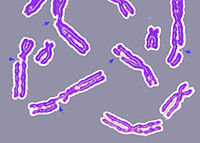
Photo from wikipedia
The formation and repair of N2-(trans-isosafrol-3'-yl)-2'-deoxyguanosine (S-3'-N2-dG) DNA adducts derived from the spice and herbal alkenylbenzene constituent safrole were investigated. DNA adduct formation and repair were studied in vitro and… Click to show full abstract
The formation and repair of N2-(trans-isosafrol-3'-yl)-2'-deoxyguanosine (S-3'-N2-dG) DNA adducts derived from the spice and herbal alkenylbenzene constituent safrole were investigated. DNA adduct formation and repair were studied in vitro and using molecular dynamics (MD) simulations. DNA adduct formation were quantified using LCMS in wild type and NER (nucleotide excision repair) deficient CHO cells, and also in HepaRG cells and primary rat hepatocytes after different periods of repair following exposure to safrole or 1'-hydroxysafrole (1'-OH safrole). The slower repair of the DNA adducts found in NER deficient cells compared to CHO wild type cells indicates a role for NER in repair of S-3'-N2-dG DNA adducts. However, DNA repair in liver cell models appeared to be limited, with over 90% of the adducts remaining even after 24 or 48h recovery. In our further studies, MD simulations indicated that S-3'-N2-dG adduct formation causes only subtle changes in the DNA structure, potentially explaining inefficient activation of NER. Inefficiency of NER mediated repair of S-3'-N2-dG adducts points at persistence and potential bioaccumulation of safrole DNA adducts upon daily dietary exposure.
Journal Title: Chemical research in toxicology
Year Published: 2020
Link to full text (if available)
Share on Social Media: Sign Up to like & get
recommendations!